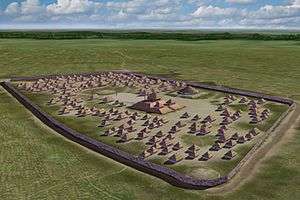Pacaha

Pacaha was a Native American tribe encountered in 1541 by the Hernando de Soto expedition. This tribe inhabited fortified villages in what is today the northeastern portion of the U.S. state of Arkansas.
The tribe takes its name from the chieftain Pacaha (born in early 16th century), who ruled the tribe from its primary village on the Mississippi River, which was thought to be located in present-day Crittenden County, Arkansas near Turrell. The site, part of the Nodena Phase, is known to archaeologists as "The Bradley Site".[1] Information about Chief Pacaha and his people comes from journals made during the expedition of Hernando De Soto in 1541. The de Soto expedition stayed at Pacaha's village for approximately 40 days.
De Soto Expedition
The initial encounter between the Pacaha and the de Soto expedition was violent. Chief Pacaha's tribe had been at war for some time with a neighboring chieftain named Casqui. The Casqui tribe is thought to have lived at a site near Parkin, Arkansas and the location of the present-day Parkin Archeological State Park.

De Soto had encountered the Casqui tribe first. When he pressed on to visit the Pacaha village, many of the Casqui people followed him. Many of the Pacaha, seeing the approach of their enemy, attempted to flee to an island in the river and drowned. The Casqui who accompanied de Soto sacked the village, desecrated holy sites, and looted valuables.
The Pacaha controlled more territory and had a larger population than the Casqui. Chief Pacaha was younger than the Casqui chief, however, and seemingly had more to lose from the continued aggressive Casqui attacks. De Soto contacted Chief Pacaha and convinced him that he had nothing to do with the attack and that the expedition's intentions were peaceful. De Soto assured the Pacaha that the expedition would help the Pacaha attack the Casqui to punish them for their subterfuge.
The Casqui received advance warning of the planned attack. They returned the looted items and apologized in order to stave off retribution. De Soto arranged a dinner for the two leaders and a peace treaty between the tribes. Chief Pacaha presented de Soto with one of his wives, one of his sisters, and another woman from his tribe. This action was in gratitude for the arrangement of peace and also to outdo his rival, who had only presented a daughter to de Soto.
The Hernando de Soto expedition records are the only historical records of Chief Pacaha and his tribe. Their later history is uncertain.
The name Pacaha was spelled Capaha in one account. Some scholars believe this word is related to the historic Quapaw tribe encountered in Arkansas by European expeditions in the 17th and 18th centuries. The primary village of the eastern Arkansas Quapaw was named Kappa or Kappah. Human and cultural remains found at the suspected Pacaha site are repatriated to the Quapaw and Tunica-Biloxi tribes, which are active.
Controversy
The accepted path of de Soto's travels was established by the research of the de Soto Commission in 1939 led by Dr. John R. Swanton. It has been generally accepted by the United States government and most archaeologists as the historic route. Some critics claim that de Soto traveled north into the states of Indiana and Illinois and found the Ohio River instead of the Mississippi River.
Due to this controversy, some claim that the town of Pacaha was located on the present-day site of Terre Haute, Indiana, and their enemies the Casqui being located near present-day Vincennes. This route is not the officially accepted route, but archaeological study and analysis continues.
See also
- List of sites and peoples visited by the Hernando de Soto Expedition
- Casqui
- Parkin Archeological State Park
- Nodena Site
- Mississippian culture
- Southeastern Ceremonial Complex
References
- Hudson, Charles M., Knights of Spain, Warriors of the Sun: Hernando De Soto and the South's Ancient Chiefdoms, University of Georgia Press, 1997. ISBN 0-8203-1888-4
- Galloway, Patricia, Editor. The Hernando de Soto Expedition. University of Nebraska Press. 1997. ISBN 0-8032-2157-6
External links
- University of Arkansas Report on de Soto travels in Arkansas
- National Park Service on de Soto's expedition
- Website on alternate theory

